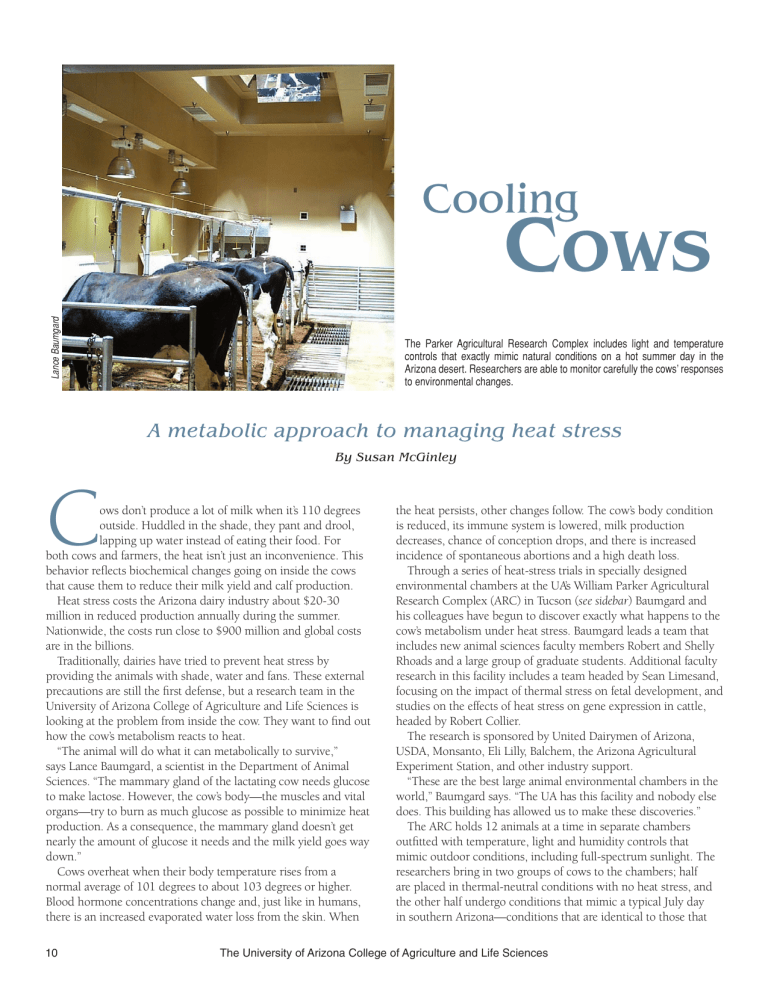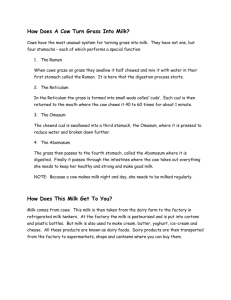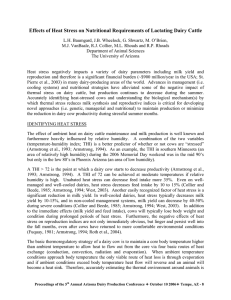Cows Cooling
advertisement

Cooling Lance Baumgard Cows The Parker Agricultural Research Complex includes light and temperature controls that exactly mimic natural conditions on a hot summer day in the Arizona desert. Researchers are able to monitor carefully the cows’ responses to environmental changes. A metabolic approach to managing heat stress By Susan McGinley C ows don’t produce a lot of milk when it’s 110 degrees outside. Huddled in the shade, they pant and drool, lapping up water instead of eating their food. For both cows and farmers, the heat isn’t just an inconvenience. This behavior reflects biochemical changes going on inside the cows that cause them to reduce their milk yield and calf production. Heat stress costs the Arizona dairy industry about $20-30 million in reduced production annually during the summer. Nationwide, the costs run close to $900 million and global costs are in the billions. Traditionally, dairies have tried to prevent heat stress by providing the animals with shade, water and fans. These external precautions are still the first defense, but a research team in the University of Arizona College of Agriculture and Life Sciences is looking at the problem from inside the cow. They want to find out how the cow’s metabolism reacts to heat. “The animal will do what it can metabolically to survive,” says Lance Baumgard, a scientist in the Department of Animal Sciences. “The mammary gland of the lactating cow needs glucose to make lactose. However, the cow’s body—the muscles and vital organs—try to burn as much glucose as possible to minimize heat production. As a consequence, the mammary gland doesn’t get nearly the amount of glucose it needs and the milk yield goes way down.” Cows overheat when their body temperature rises from a normal average of 101 degrees to about 103 degrees or higher. Blood hormone concentrations change and, just like in humans, there is an increased evaporated water loss from the skin. When 10 the heat persists, other changes follow. The cow’s body condition is reduced, its immune system is lowered, milk production decreases, chance of conception drops, and there is increased incidence of spontaneous abortions and a high death loss. Through a series of heat-stress trials in specially designed environmental chambers at the UA’s William Parker Agricultural Research Complex (ARC) in Tucson (see sidebar) Baumgard and his colleagues have begun to discover exactly what happens to the cow’s metabolism under heat stress. Baumgard leads a team that includes new animal sciences faculty members Robert and Shelly Rhoads and a large group of graduate students. Additional faculty research in this facility includes a team headed by Sean Limesand, focusing on the impact of thermal stress on fetal development, and studies on the effects of heat stress on gene expression in cattle, headed by Robert Collier. The research is sponsored by United Dairymen of Arizona, USDA, Monsanto, Eli Lilly, Balchem, the Arizona Agricultural Experiment Station, and other industry support. “These are the best large animal environmental chambers in the world,” Baumgard says. “The UA has this facility and nobody else does. This building has allowed us to make these discoveries.” The ARC holds 12 animals at a time in separate chambers outfitted with temperature, light and humidity controls that mimic outdoor conditions, including full-spectrum sunlight. The researchers bring in two groups of cows to the chambers; half are placed in thermal-neutral conditions with no heat stress, and the other half undergo conditions that mimic a typical July day in southern Arizona—conditions that are identical to those that The University of Arizona College of Agriculture and Life Sciences The lab at the Parker Agricultural Complex includes two bays for observing cows. These can be checked from windows on either side of the computer stations set up to monitor their temperature and other bodily functions. and they are more insulin sensitive, although it’s not yet clear why. The goal is to use these findings to improve or adjust the cow’s metabolism through dietary strategies that will enable it to withstand heat stress, according to Baumgard. For example, there could be a way to enhance digestion to increase energy, or to improve the body’s utilization of glucose. Dietary regimes that increase glucose production or reduce insulin sensitivity may increase milk yield, because milk production is dependent on nutrient availability. The feed and pharmaceutical industries are interested in this research because of the huge market it represents for introducing possible feed or veterinary supplements. The William J. Parker Agricultural Research Complex The William J. Parker Agricultural Research Complex (ARC) is a highly specialized structure designed for the study of environmental factors affecting livestock performance. Managed by the UA Department of Animal Sciences, the multipurpose building features highly advanced environmental controls for light, temperature, humidity and other factors that will allow faculty to conduct integrated studies in physiology, biochemistry, nutrition and molecular biology. The complex includes two rooms equipped with full-spectrum solar lighting that simulates almost exactly the intensity and radiance of sunlight. There are also surgical facilities for treating sick and injured livestock, offices and meeting areas for faculty and students and holding areas for livestock. Once all construction is complete, the building will gross 46,560 square feet. The facility was named in honor of William J. Parker, who moved to the United States from Ireland in 1921. His family has operated dairies in Arizona and California under Shamrock Dairy, and also owns and operates Parker Dairy in Congress, Arizona. According to Parker’s son, Jim, the family chose to support the ARC to acknowledge the research and extension help they have received over the years from the UA College of Agriculture and Life Sciences. By sponsoring research that will improve dairy production, the Parkers’ gift also supports the agricultural industry that has benefited their family for generations. A condition called rumen acidosis develops, which is similar to an “upset” stomach in humans. Baumgard notes that any new techniques for reducing heat stress in dairy cattle would still be implemented in tandem with the shade and evaporative cooling systems during the summer months. “Heat stress is a burden that’s unparalleled in our industry,” he says. “This research has generated a lot of interest, especially in Arizona, which is understandable when you consider that a typical dairy with 3000 cows loses approximately 10 pounds of milk per day during the three summer months, equaling approximately 270,000 pounds. With a milk price of 12 cents a pound, that’s $337,000 in costs to the dairyman.” Lance Baumgard dairy cattle might normally experience in Maricopa County, for example, where temperatures reach 105 degrees during the day and 95 degrees at night. “We compare thermoneutral and heatstressed cows, measuring levels of insulin, growth hormone, epinephrine, glucose and other factors,” Baumgard says. The researchers have found that as cows eat less—one of their first responses to heat stress—their bodies begin to preferentially burn glucose. In contrast, an underfed cow in thermal neutral conditions burns fat. Since animals need glucose for energy, heat-stressed cows go into a negative energy balance. “We’ve discovered that glucose production in a heat-stressed animal is of utmost importance,” Baumgard says. The team has found that one of the typical signs of heat stress—a cow’s tongue hanging out—actually points to a serious internal problem. When a cow breathes heavily and drools, it eventually dehydrates and produces less saliva. This reduces the buffering capacity in its mouth as it eats, and in turn changes the pH balance in the cow’s rumen. A condition called rumen acidosis develops, which is similar to an “upset” stomach in humans. “We’re still trying to characterize the changes going on and we’re naming these changes,” Baumgard says. “If we have a better understanding of the biological reasons why heat stress reduces milk yield, we will have a better idea of how to alleviate it.” Results so far have indicated that heat stress reduces feed intake by 30 percent and milk yield by 45 percent. The cow’s lack of appetite, leading to underfeeding, reduces milk yield by 19 percent. The research has also shown that heat stressed cows require extra energy, Dairies in other arid regions of the world stand to benefit as well. Baumgard is the first scientist to systematically evaluate the impact of thermal stress on the metabolism of dairy cows. However, his research extends beyond the dairy industry. For example, although beef producers traditionally haven’t concentrated on cooling feedlots, Baumgard says this research should transfer to “how we handle and feed all heat-stressed animals, including other breeds of livestock besides the big dairy breeds.” “It’s a long-term project, wide open to major advances and we plan on making significant contributions,” he says. “We’ll be in this for a few years.” Ã Contact Lance Baumgard 520-621-1487 baumgard@ag.arizona.edu 2006 Agricultural Experiment Station Research Report 11




